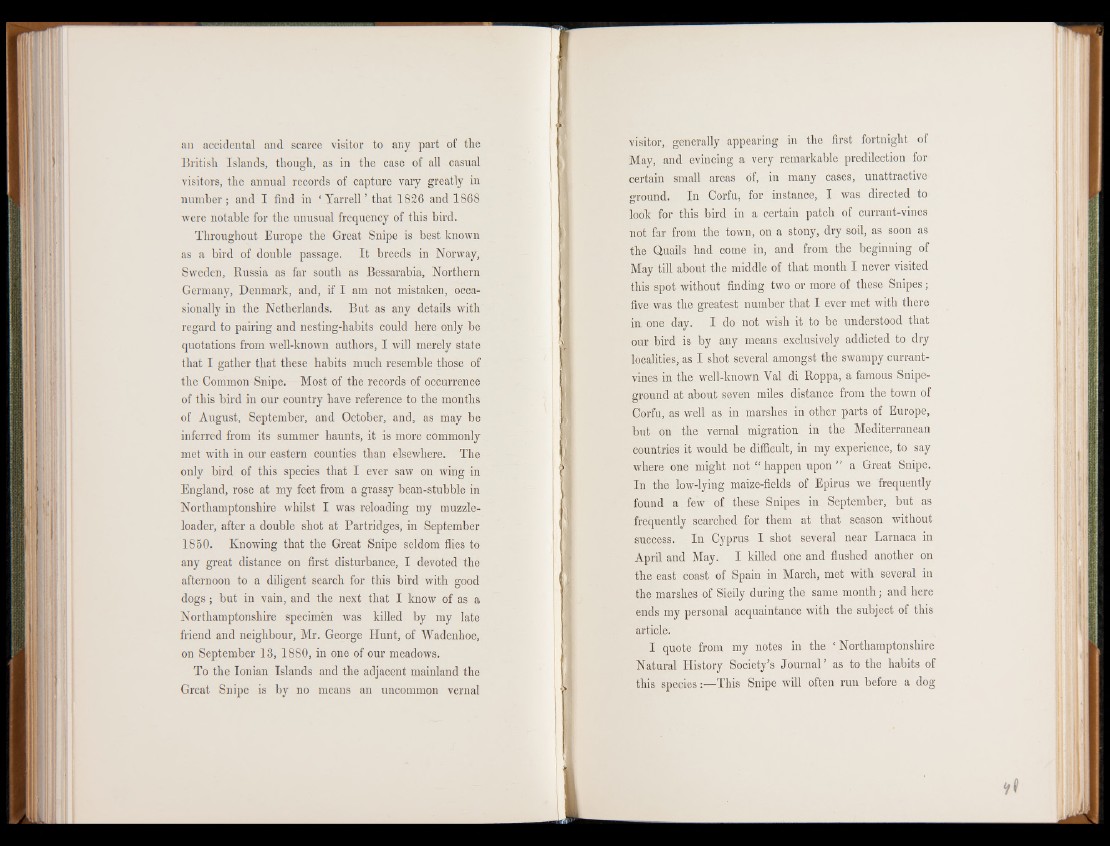
an accidental and scarce visitor to any part of the
British Islands, though, as in the case of all casual
visitors, the annual records of capture vary greatly in
number ; and I find in ‘ Yarrell ’ that 1826 and 1868
were notable for the unusual frequency of this bird.
Throughout Europe the Great Snipe is best known
as a bird of double passage. It breeds in Norway,
Sweden, Russia as far south as Bessarabia, Northern
Germany, Denmark, and, if I am not mistaken, occasionally
in the Netherlands. But as any details with
regard to pairing and nesting-habits could here only be
quotations from well-known authors, I will merely state
that I gather that these habits much resemble those of
the Common Snipe. Most of the records of occurrence
of this bird in our country have reference to the months
of August, September, and October, and, as may be
inferred from its summer haunts, it is more commonly
met with in our eastern counties than elsewhere. The
only bird of this species that I ever saw on wing in
England, rose at my feet from a grassy bean-stubble in
Northamptonshire whilst I was reloading my muzzle-
loader, after a double shot at Partridges, in September
1850. Knowing that the Great Snipe seldom flies to
any great distance on first disturbance, I devoted the
afternoon to a diligent search for this bird with good
dogs; but in vain, and the next that I know of as a
Northamptonshire specimen was killed by my late
friend and neighbour, Mr. George Hunt, of Wadenhoe,
on September 13, 1880, in one of our meadows.
To the Ionian Islands and the adjacent mainland the
Great Snipe is by no means an uncommon vernal
visitor, generally appearing in the first fortnight of
May, and evincing a very remarkable predilection for
certain small areas of, in many cases, unattractive
around. In Corfu, for instance, I was directed to
look for this bird in a certain patch of currant-vines
not far from the town, on a stony, dry soil, as soon as
the Quails had come in, and from the beginning of
May till about the middle of that month I never visited
this spot without finding two or more of these Snipes;
five was the greatest number that I ever met with there
in one day. I do not wish it to be understood that
our bird is by any means exclusively addicted to dry
localities, as I shot several amongst the swampy currant-
vines in the well-known Yal di Roppa, a famous Snipe-
ground at about seven miles distance from the town of
Corfu, as well as in marshes in other parts of Europe,
but on the vernal migration in the Mediterranean
countries it would be difficult, in my experience, to say
where one might not “ happen upon” a Great Snipe.
In the low-lying maize-fields of Epirus we frequently
found a few of these Snipes in September, but as
frequently searched for them at that season without
success. In Cyprus I shot several near Larnaca in
April and May. I killed one and flushed another on
the east coast of Spain in March, met with several in
the marshes of Sicily during the same month; and here
ends my personal acquaintance with the subject of this
article.
I quote from my notes in the ‘ Northamptonshire
Natural History Society’s Journal ’ as to the habits of
this species:—This Snipe will often run before a dog